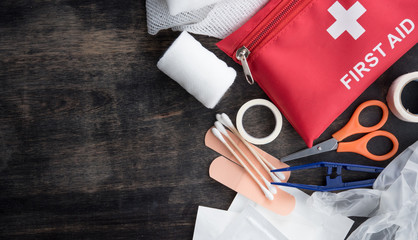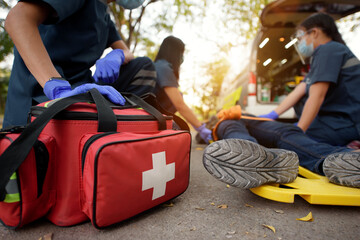Emergencies come unannounced, and in those crucial moments, a well-equipped first aid kit can be the difference between a minor inconvenience and a life-threatening situation. Whether in the wild, at the workplace, or managing the hustle and bustle of family life, the presence of a first aid kit can offer a sense of security. For this detailed blog post, we're going to explore the comprehensive essentials of on-site first aid kits, intended to resonate with outdoor enthusiasts, workplace safety managers, and parents. Understanding what to have in these kits is an essential part of preparing for the unexpected.

The Crucial Role of First Aid Kits
First aid kits are the first line of defense in attending to injuries. They are vital for treating cuts, scrapes, burns, sprains, strains, and more serious injuries until professional medical help is available. These kits serve as a micro-hospital, allowing for immediate care, and could often prevent a condition from escalating.
In any setting, be it at home, the workplace, or out camping, being prepared with a comprehensive first aid kit is non-negotiable. They instill confidence in responding to emergencies and can positively influence outcomes in critical situations.
Components of a Comprehensive First Aid Kit
Basic Supplies and Their Uses
A standard first aid kit should contain basic supplies:
-
Adhesive bandages in various sizes
-
Sterile gauze pads
-
Adhesive tape
-
Bandage scissors
-
Tweezers
-
Antiseptic wipes
-
Antibiotic ointment
-
Pain relievers
-
Sterile gloves
These basic supplies are essential for cleaning and covering minor cuts and scrapes, stabilizing sprains, and reducing pain and swelling.
Advanced Supplies for Specialised Needs
Beyond the basics, a well-rounded first aid kit may include:
-
Latex tourniquet bands
-
Burn cream
-
Eye wash solution
-
Triangular bandages for slings
-
Oral rehydration salts
-
Instant cold compress
-
CPR face shield
Each of these items caters to specific injuries that might require a higher level of care, such as major bleeding, burns, eye irritations, or dehydration.
Tailoring First Aid Kits for Different Audiences
Different audiences require different focuses in their first aid kits.
Outdoor Enthusiasts
For those who spend time in the great outdoors, first aid kits must cater to the remote and rugged nature of outdoor activities. Such kits should include:
-
Emergency blanket
-
Whistle
-
Compass
-
Snakebite suction vacuum
-
Tick removal tool
-
Splint
Outdoor kits often need to cover a larger spectrum of incidents due to the increased risk and difficulty in obtaining medical assistance when far from civilization.
Workplace Safety Managers
Workplace first aid kits should be designed according to the specific hazards of the industry. For instance:
-
Industries with chemical exposure should have neutralizing solutions
-
Construction sites commonly require trauma dressings and more tourniquets
-
Office environments would necessitate burn creams and eyewash solutions
Each workplace environment is unique, and risk assessment is key to tailoring a first aid kit for optimal use.
Parents with Young Children
Parents need a first aid kit that addresses the common injuries of childhood, including:
-
Child-friendly bandages and antiseptics
-
Oral pain relief medication
-
Thermometer
-
Calamine lotion for rashes
-
Age-appropriate health information
The focus here is on comfort and specialised care for little ones, and the kit may require updating as the child grows.
Best Practices and Regulations
Compliance with safety standards is an important aspect of first aid kit management:
-
Ensure that your first aid kit meets OSHA and ANSI requirements if in a work environment
-
Familiarize yourself with local regulations for first aid kits in public spaces
-
Verify expiry dates of all products regularly and restock as needed
Ensuring that your first aid kit adheres to standard guidelines will provide legal protection and the highest level of care in any situation.
Real-Life Scenarios
Incorporating case studies can showcase the importance of accessible first aid kits:
-
A hiker with an ankle injury requiring a makeshift splint from their outdoor first aid kit
-
A workplace accident where the timely application of a tourniquet saved a life
-
The quick provision of first aid to a child with a minor burn, preventing panic and further injury
First Aid Kits for Work
In the workplace, having an adequately stocked first aid box is not just best practice; it's a duty under various regulations that govern workplace health and safety. The contents of a workplace first aid kit are influenced by several factors, including the number of employees, the nature of the work being performed, and access to medical supplies. At the very least, every first aid kit should contain the minimum quantity of aid equipment required for the well-being of both employees and visitors. This includes aid dressings, adhesive dressing strips specifically designed for various types of injuries, elastic adhesive for securing dressings, and padding to protect wounds.
A suitable variety of medical supplies ensures that for any common workplace injury, the first response can be immediate and effective. Key items also include scissors and forceps for the application and removal of dressings, and compact, portable kits are preferred for easy access and efficiency in emergencies. Over the years, the regulation regarding what must be included in a first aid box has evolved, reflecting the sharing of best practices and advances in first aid treatment. Ensuring your workplace is equipped with the correct number and types of first aid supplies is fundamental to promoting health and safety, as well as ensuring quick response times in the event of an injury, thereby aiding in the conservation of health and well-being of all present.

Conclusion
The meticulous assembly and maintenance of first aid kits is an exercise in vigilance and care. It’s a commitment to personal and collective safety. Regardless of where life takes us, a well-stocked first aid kit, tailored to the situation and audience, provides the confidence and tools needed to tackle unforeseen challenges.
In closing, the emphasis on on-site first aid kits is not just a matter of compliance or preparedness; it's a narrative of human resilience. It's about understanding that the smallest of acts, informed by the right tools, can yield immeasurable impacts. Whether you’re a survivalist charting the wilderness, a professional safeguarding the workplace, or a parent nurturing the next generation, the story of the first aid kit is a universal and undying testament to human care and ingenuity.
